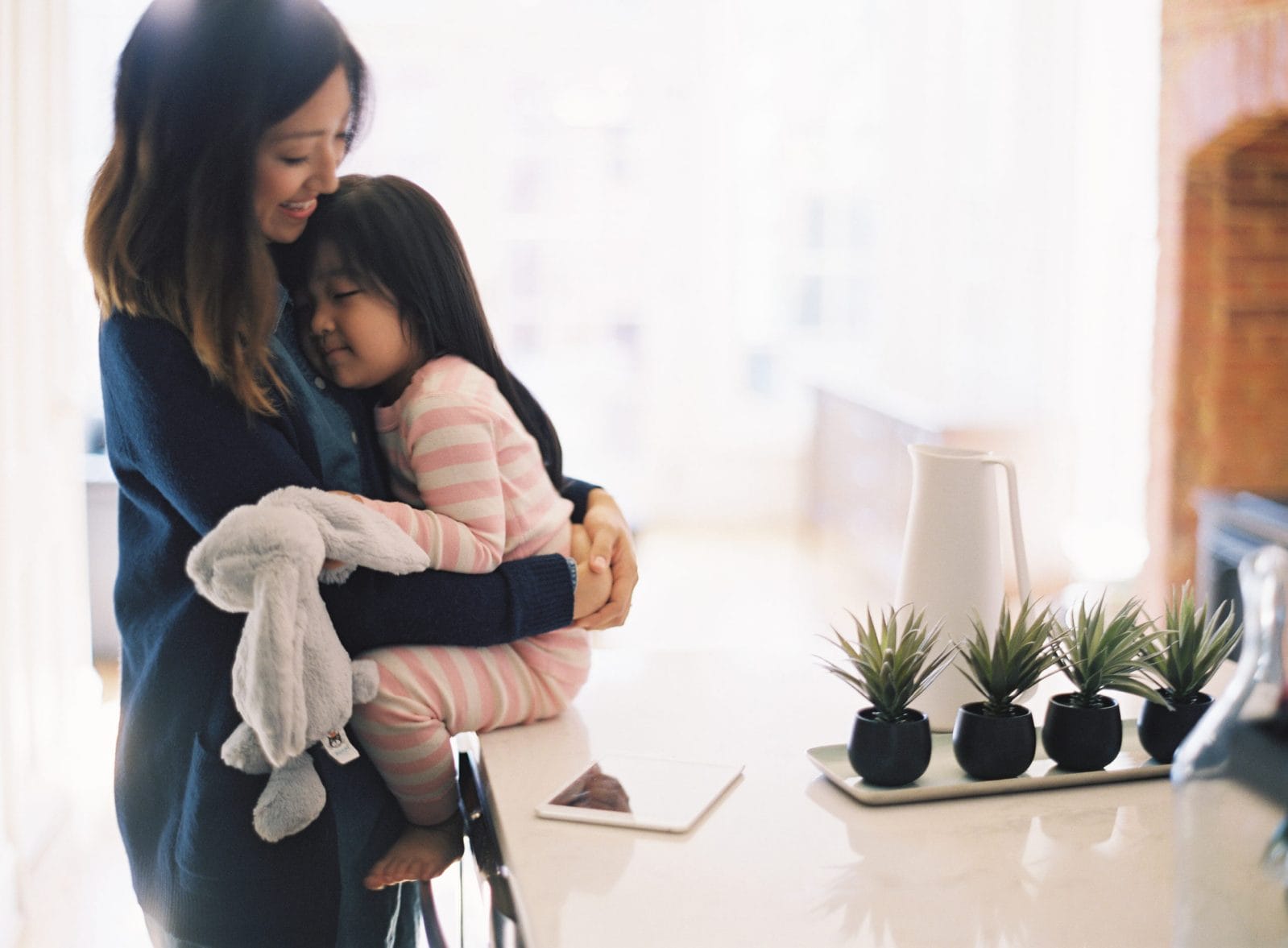Your child can’t be “too attached”

Here's why clinginess can be a good sign.
Your child is sitting next to you, so close that you’re actually touching. Together, you’re building a house for her dolls, and then it hits you…you have to pee, like bad.
As you do your “I gotta go” dance toward the bathroom, you reassure your daughter that you will be back in 2 minutes to play. A few steps into your retreat, she melts down, crying and clinging to you, and in that moment, you feel a mix of emotions—frustration, annoyance, concern. You want to care for yourself and your child.
When it comes to playing independently or being away from your side for more than a second (and yes, sometimes it feels like an actual second) before she is tugging and pulling or following behind you in tears, your child struggles. The reality is, your “to do” list is growing, self-care feels like a forgotten art, and you wonder, am I doing it wrong?
But you can rest easy, as research says that quite the contrary is true. Her “clinginess” may actually be a good (even healthy) thing.
Let’s break this down to see what research tells us about the path towards secure attachment in early childhood.
Early attachment
In the first year of life, children attach to their caregiver as a biological instinct to stay safe. When a baby is hungry, tired, wet or wants connection, she cries to let us know she has needs. As parents, the way we respond to those needs creates a template for the way she sees herself and others, and close relationships in general. This working model acts as an internal guidance system for filtering experiences in the world.
Research shows that early emotional bonding is vital for forming a secure attachment. When your child cries and you respond by picking her up, using a comforting tone, or touching her to communicate safety, you reflect back your baby’s emotions, giving them meaning and regulating them. Your child begins to recognize that she can count on you and views you as a safe haven during times of distress and a secure base to explore the environment when regulated. This type of parenting teaches children that others recognize their needs, and establishes foundations for trust, empathy, understanding relationships, and verbal and non-verbal communication.
Parental concerns + attachment
Yet, many parents still wonder, Is my child too attached? Parents often fear that in being too responsive to their child’s needs, they will hinder their growth as independent beings. But as rational as these fears might appear at first glance, science tells us that, in simplified terms, a met need integrates, and here’s what the experts mean by “integrate” (spoiler alert, it’s good).
Attachment provides safety for children to explore and step into their independence to learn new skills. According to Dr. Deborah MacNamara, author of the best-selling book Rest, Play, Grow: Making Sense of Preschoolers (or Anyone Who Acts Like One) (or Anyone Who Acts Like One), and the Director of Kid’s Best Bet Counselling and Family Resource Centre:
“Children can’t be too attached, they can only be not deeply attached. Attachment is meant to make our kids dependent on us so we can lead them. It is our invitation for a relationship that frees them to stop looking for love and to start focusing on growing. When kids can take for granted that their attachment needs will be met, they are freed to play, discover, imagine, move freely and pay attention. It is paradoxical but when we fulfill their dependency needs, they are pushed forward towards independence. As a child matures, they will likely become more capable of taking the steering wheel in their own life and we will be able to retreat into a more consulting role.”
Attachment then does not deter growth, it fuels it.
So, back to your clinging child who is pulling at your leg as you attempt to break to the bathroom: In this case, her clinginess is a sign that she considers you a secure base. She believes, through prior experience, that you are available and sensitive to her needs. Simply put, her clinginess is a sign that she trusts you.
Insecure attachment
When children do not have secure attachments with their caregivers, however, they feel that they can’t rely on them when needed. Studies show that these babies and toddlers are actually less clingy in scary situations. Children who feel their needs are not met may experience increased anxiety and may have difficulty regulating emotions, understanding body signals and interacting with peers. Other children learn strategies for achieving and holding attention such as over-compliance, constant smiling or disruptiveness.
While clinginess may be a sign of healthy development in young children, it doesn’t always make it less overwhelming for parents who are juggling the gazillion roles that come with being a parent.
Here are a few tools to help your child (and you too) during these moments:
1. Check-in with you:
- Pause. When your child is clinging to your leg or refuses to play independently, know that nothing is broken. This gives you the power to be with “what is” in that moment. Pause and notice what feelings your child’s behavior brings up for you. Are you frustrated, anxious, worried, depleted? Allow for your feelings, breathe, and center yourself before addressing your child.
- Release goals. Once you feel less triggered, notice any goals that you’ve set for your child. If your goal, for example, is for your child to play independently so you can use the bathroom, do the dishes, or have a moment to yourself, cancel the goal. While your goals are valid and good, we can only control our own thoughts, words, and actions. When we turn our goals inward, we move into our power and can better be with our children.
- Take self-care breaks. Ask your partner, a family member, or babysitter to look after your kiddo while you take the time needed to recharge. It can be challenging to fill your child’s emotional tank if yours is empty.
- Set boundaries. It is ok to set a boundary for yourself to have a cup of coffee, take an uninterrupted shower, or chat with a friend. Your child may have big emotions surrounding this, and you can meet them with empathy while still holding to your loving limits. Give yourself permission to temporarily step away while also giving permission for your child to feel their emotions.
2. Give special time:
- Fill your child’s emotional bucket in ways that are meaningful to them. Does your child like to read books, cuddle, run outside? Spend 10 minutes each day filling your child’s tank by giving them “special time” that they can count on every day. Name it, schedule it, and help your child know that they are powerful and at the top of your list.
3. Teach patience:
- It’s hard for our children to wait, especially when they want our attention and it is directed elsewhere. “To wait” is a skill and we can help teach patience and impulse control through small moments throughout the day. This can be done with games such as Red Light Green Light or by offering intentional delays during tasks. Acknowledge to your child that waiting is hard, and help them wire their brain for this skill.
4. Help them play alone: If your child doesn’t like to play by themselves, here are some things you can try:
- Play together and, after about 15 minutes, play a little less and watch a little more. Once that transition is tolerated, back up a bit to give your child some space. Eventually, increase the distance until they feel comfortable with you stepping away.
- Another option is to use a timer. When you want to step away, invite your child to set a timer, offering her a concrete time for your return. “Let’s set the timer for 5 minutes while I do the dishes, and when it buzzes, I will come back.” This can help your child become used to you leaving for short intervals. As your child feels more comfortable, you can slowly increase the time.
- Involve your child. Ask your child what would help them feel more comfortable when you need to step away. By involving her in the process, she may be more motivated to participate in the plan.
While a clinging child may put you at a loss when it comes to knocking things off the ‘ole to-do list, one thing you can cross off your list is parent guilt. Secure attachment is an ongoing relationship between you and your child. As you communicate safety and respond instead of react to your child’s needs, they can and will (it takes time…years!) feel more secure in exploring, learning and growing.
So, you ask, are you doing it wrong? No way…not even a little.
This post originally appeared on Generation Mindful.


































